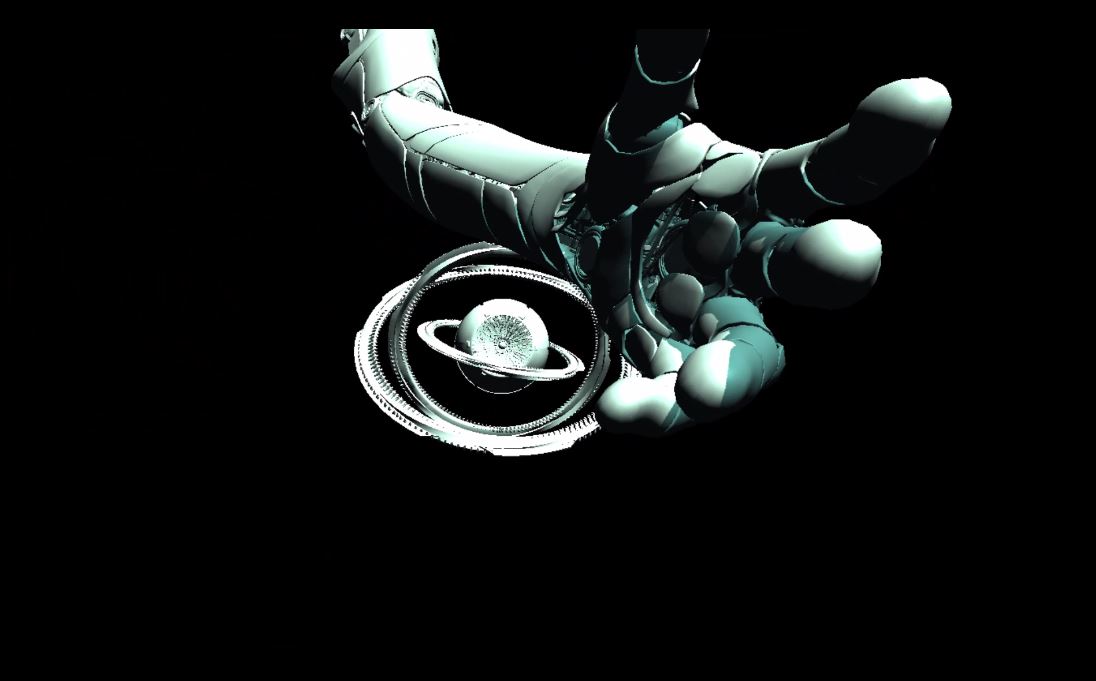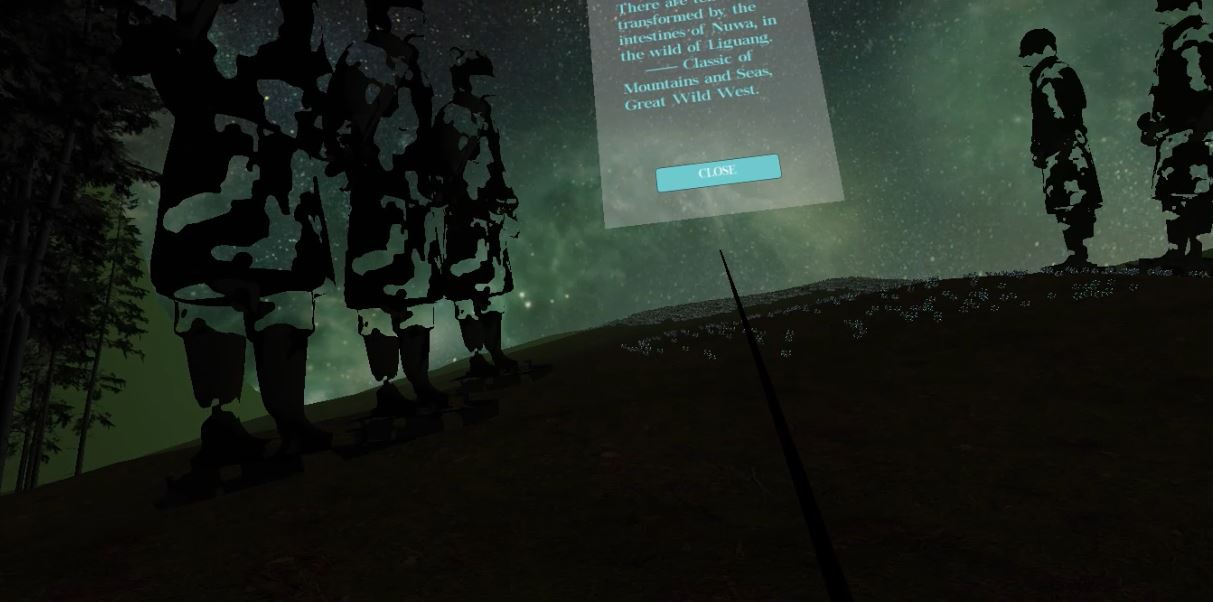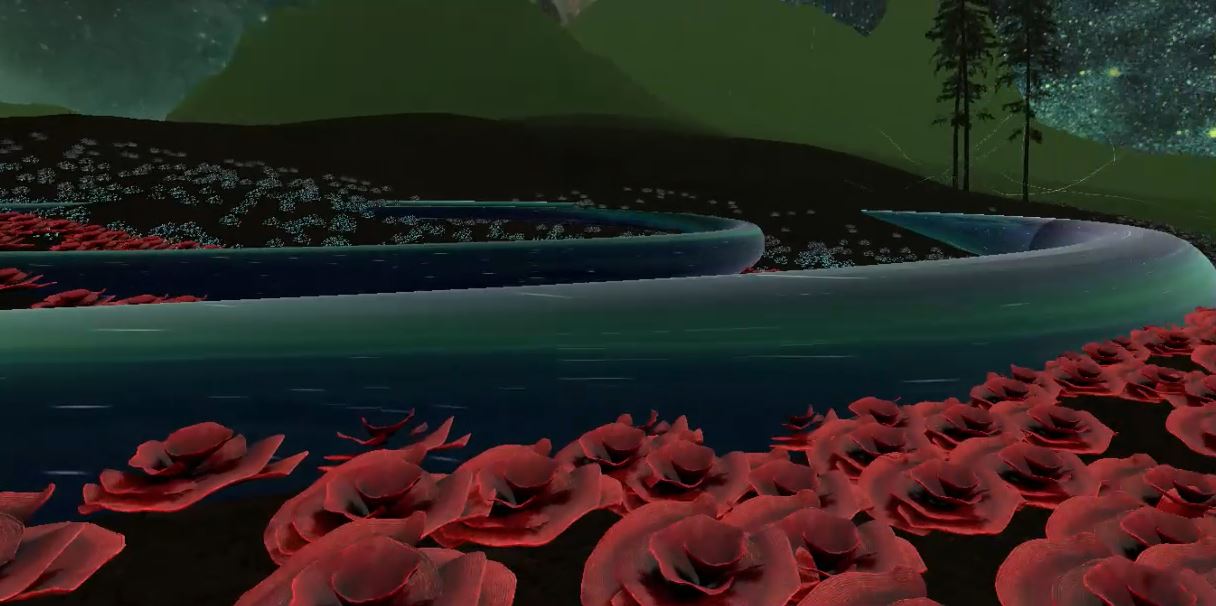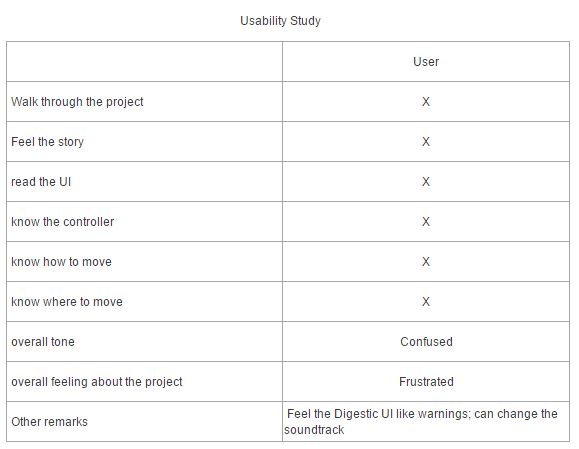NV WA
Nv Wa is the reconstruction of the Chinese Nuwa myth based on the feminist concepts "cyborg" and "goddess" in the context of global technology virtualization. The recall of divinity and legitimacy of women.
It is a VR project and developed on Unity 20.1.
produced by: Jingyi Chen
Introduction
The first scene is the standby scene, with a huge arm hanging high. The player needs to click on this arm to start. I hope this arm can give people a sense of strength and memories of God and Adam painted by Michelangelo. This arm is a mechanical arm, which represents a kind of power brought by technology.
In the second scene, it can be felt that this is a child's room. The particle-built room brings a kind of memory blur and the sound of parents arguing in the distance. This is based on part of the creator’s childhood experience. The bondage and responsibilities brought about by marriage also bring endless disputes and trivialities. Witnessing the mother's consumption affects a girl's childhood experience and future development. Players can use the handle to grab the puppets and throw them out. Through exploration, they found that by clicking on the door of the room, they could escape this suffocating environment.
The third scene is a dream-like scene. A mother told a girl the story of the Chinese goddess of creation, Nvwa. Players can use buttons to control the growth and shrinkage of plants. When it comes to the story of Nvwa’s creation of humans, players can inspire the vitality of the land by touching the ground with the controllers. I hope they can feel the same sense of power and control as the ancient goddess through technology in the VR world. In the remaining part, I hope to reproduce the dreamlike feeling of ancient mythology.
In the end, the mother said that Nuwa hadn't disappeared, she was here, and the scene jumped to the last one. Over the modern city, the player's hands become mechanical arms, and a huge cyborg goddess grows out of the city. Through technology, a goddess with creativity and power is reborn in our city. I hope to encourage women to find divinity and legacy through technology.
Concept and background research
To stimulate women's initiative, the construction of role models and narratives is very significant. Besides the role of mother, wife, daughter, or maid, and so on, there are more possibilities that remain to be invented in feminist writings. Graham (1999) compares two main types of powerful female roles, cyborgs and goddesses. The concept of cyborg in feminism is introduced by Donna Haraway (1985) in her famous article Cyborg Manifesto, and she regards the cyborg as a symbol of breaking traditional dualism boundaries, an incarnation in the global techno-science situation, and a provocation to the reconstructed "naturalism". In contrast, Haraway despises Goddesses and thinks they are "an impediment of human autonomy", due to the influence of Marxism and post-enlightenment. Goddesses have been alienated and tampered with to become affiliated and subordinate to male Gods. The second-wave feminists have disclosed the importance of correcting the image of Goddesses. Christ (1978) states the importance of the goddess as a subconscious symbol which is helpful to women pursuing dependence and legitimacy in political and social institutions, as the male God has ever empowered men. The goddess will help women to fight against the denigration of menstruation, childbirth, and menopause; encourage women to assert and achieve their wills and reinforce women's bonds and heritages, especially those between mothers and daughters. In Greek myth, Demeter infuriated and fought for her snatched daughter Persephone, but in Chinese myth lack of similar myths emphasise the bondage of mothers and daughters; there are more myths about the romantic loyalty to husbands. Therefore, some mothers do not regard their daughters as real heirs and become accomplices of patriarchal oppression. Daughters are not legitimated heirs in classic texts, and this might be one of the reasons for the phenomenon of "missing women" in China. Irigaray, who made a significant contribution to women's divinity, thinks goddesses as evocative and eco-friendly. As she notes, "Divinity is what we need to become free, autonomous and sovereign" "As long as women lack divine made in her image, she cannot establish her subjectivity or achieve a goal for her own" (1993).
The praise for the goddess can be seen in the famous work The Dinner Party of Judy Chicago (1974-1979). In this art masterpiece, she made a dinner table to honour thirty-nine goddesses, heroines, and other remarkable females in history. She pays tribute to vulvas by ceramics, embroidery, and engraved other 998 women's names on the tiles. The specular work is a monument for demonstrating the forgotten achievement of women.
The Dinner Party.
The power of the goddess is also can be demonstrated recently in a virtual reality project NeuroSpeculative AfroFeminism (2018). Hundreds of years later, three black women are in a Neurocosmetology lab. The audience can look outside from a black girl's body to give a glimpse to the world in which black women are "pioneer techniques of brain optimisation and cognitive enhancement". By rituals, she travels the multiverse and sees three great goddesses. The goddesses tell she is free and powerful to break any confinements. The visual of this project is to combine coloured women with magical futurism elements to empower and enhance their mentality with technological confidence. The goddesses function implicitly as the divine guides and mental support in the posthuman era. It also embodies the concept of "cyborg" to some degree to connect the spirit of the audience and the virtual character through encephalic enhancement and occupation by virtual reality technology.
Godesses in Neurospeculative Afrofeminism
The images of Cyborg and the Goddess are both very potent, moreover, and they are not necessary to be separate and exclusive mutually. The cyborg is provocative, tech-savvy, non-binary, and the goddess is divine, legitimated, and transcendental. The combination of cyborg and goddess is the foundation stone of my idea. Due to my background, I want to refer to Chinese culture. Therefore, I choose to develop the Chinese goddess Nvwa, one of the most important goddesses in Chinese culture. She is the combination of human and animal, a chimera, has a human face and snake body, implied the ancient people's awe of nature. She created humans by spilling clay and protected them from catastrophes. Therefore, she is the goddess of transformation and reproduction. In addition, she is the most popular goddess in Chinese culture. According to Classic of Mountains and Seas, she was not only a Goddess but an emperor. I think the breaking and reconstruction of indigenous classic texts and images are very important for the development of Chinese feminism. Inspired by the concept of cyborg and the goddess, I want to create a mysterious, organic but also technical and fantastic world via virtual reality to revoke the feeling of being powerful, unstrained, and productive, especially for women. I want to suggest by mastering technology, women are not submissive and strengthless but powerful enough to control, pilot and revive. Some people have realised the escapism via virtual reality and other technologies to hide their discriminated bodies in cyberspace. (Noble 1999) (Haraway 1985) (Gibson 1984) Like choosing a perfect and potent avatar, to reach "effacement of physical corporeality" (Graham, 1999). Even in cyberspace, women should be confident and proud of their gender, face up to their identities. That is the reason for the creator in Neurospeculative Afrofeminism to put a mirror in front of the black girl as well as the audience.
Technical
The project is developed on Unity 2020.1 and Oculus rift s. The reason I chose virtual reality is that VR represents the future development direction and is a good carrier for storytelling. At the same time, VR makes the audience more immersive.
In this project, I used trigger zones, timeline, shader graph, VFX graph, Dotween, and diegetic UI. Wrote scripts to get data from controllers to enable and disable game objects, create transition animations, play audios, trigger scenes, control timeline and so on.
To achieve the atmosphere of technical and fantastic, I used VFX graph and its particle system. Adjusted the arguments to fit my project, and then I controlled them by the script. When the controllers’ positions are below the threshold, the VFX’s scale will change from 0. I also create shader graphs for sculptures and planets. By activate trigged zones, the objects and materials will move and change.
In addition, I used the library Dotween to achieve the great transition of animation. It creates great transitions of sizes and positions.
In the second scene, I converted the volume of the sound into the jitter of the dolls, use the GetSpectrumData() function.
After the first version of this project, I conducted some usability tests, changed the UI interfaces to narrations and made the camera move automatically because in the tests I found people who never played VR do not know how to use controllers to move and felt upset about it, so I changed the interaction to minimal; also during the exhibition, I observed how people interact with the project and modified it several times to reduce their difficulties to complete the journey.
In the first version, the audiences are upset about the texts and the movement.
Future development
I enjoyed the process of recreating myths and exploring visuals. In the process of creating, I found there is a lack of classic images of indigenous goddesses, whether digital or physical. Therefore, it is worthwhile unearthing the potential in this field. Because I do not know how to model, so I some ready-made models and modified them in C4D and Mixamo. However, during developing VR projects I found to use models created by myself is very significant, especially refer to visual performance. So, I will improve my modeling ability.
Also, I would make the styles of the scenes more unified. The styles of the various scenes are somewhat inconsistent due to the plot, so it is necessary for them to be more coherent in experience.
Self evaluation
I enjoyed doing the work because it is amazing to compose separate materials together in various scenes. Unity is a powerful and mature platform that has a lot of resources I can try my ideas as much as possible. By doing this, I also improved my C# and Unity ability a lot, including texturing, lighting, rigging, and animation. Meanwhile, I dived into the western feminist theory, observed the situation of feminism in China recently and combined my research with the work greatly to let the audience feel the missed legitimacy and powerfulness of Chinese women in narratives for thousands of years. But I think I should make the whole experience more concise and intertwined, the style more unified, and the scenes more artistic. I am happy to see the audiences amazed when they saw the plants grow and the goddess appears. I should keep trying different ideas and make better experiences and styles. I am glad that I conducted some user tests in advance and the tutors points out what might upset them in the early stages. During the exhibition, I can see clearly the reaction of the audience and hear their feelings about the magic world. In the process, I can explore how to tell a better story in the virtual world and make more accessible interactions.
References
Theory
- Bassett, C., Kember, S., & O'Riordan, K. (2019). Furious: Technological feminism and digital futures. Pluto Press.
- Christ, C. P. (1979). Why women need the goddess (p. 273).
- Fincher, L. H. (2018). Betraying big brother: The feminist awakening in China. Verso Books.
- Gibson, W. (2015). Neuromancer (Vol. 1). Aleph.
- Graham, E. (1999). Cyborgs or goddesses? Becoming divine in a cyberfeminist age. Information, Communication & Society, 2(4), 419-438.
- Guan, Z. & Zhang, L. (2020) ‘阿里巴巴的进化史与小资本主义的平台化: 对本土语境平台
- 化的考察’[‘The Evolutionary History of Alibaba and the Platformization of Small Capitalism: An Investigation of the Platformization of Local Context’]. ‘国际新闻界’
- [‘International press’], 42(2), 28-49.
- Haraway, D. (1985). A cyborg manifesto: Science, technology, and socialist-feminism in the late 20th century. In The international handbook of virtual learning environments (pp.
- 117-158). Springer, Dordrecht.
- Irigaray, L. (1993). Sexes and genealogies. Columbia University Press.
- Laboria Cuboniks. (2015). Xenofeminism Manifesto.
- https://laboriacuboniks.net/manifesto/xenofeminism-a-politics-for-alienation/ [accessed
- 01/04/2021]
- Li, S., (2020). ‘微博女权的前世今生: 从“政治正确”到“商业正确” [‘The Past and Present of
- Feminism on Weibo: From "Political Correctness" to "Commercial Correctness"’]. The paper. https://www.thepaper.cn/newsDetail_forward_7854160 [accessed 23/03/2021]
- Missing women. Wikipedia. https://en.wikipedia.org/wiki/Missing_women [accessed
- 22/04/2021]
- Neurospeculative Afrofeminism. Hyphen-labs. http://www.hyphen-labs.com/nsaf.html
- [accessed 22/04/2021]
- Noble, D. F. (2013). The religion of technology: The divinity of man and the spirit of invention. Knopf.
- Peng, A. Y. (2019). Neoliberal feminism, gender relations, and a feminized male ideal in China: A critical discourse analysis of Mimeng’s WeChat posts. Feminist Media Studies, 21(1), 115-131.
- Peng, A. (2020a). Digital nationalism vs. gender politics in post-reform China: Gender-issue debates on Zhihu. Global Media and Communication.
- Peng, A. Y. (2020b). Alipay adds “beauty filters” to face-scan payments: a form of patriarchal control over women’s bodies. Feminist Media Studies, 20(4), 582-585.
- Srnicek, N. (2017). Platform capitalism. John Wiley & Sons.
- The dinner party. Wikipedia. https://en.wikipedia.org/wiki/The_Dinner_Party [accessed
- 22/04/2021]
- Wajcman, J. (1991). Feminism confronts technology. Penn State Press.
- Wallis, C., & Shen, Y. (2018). The SK-II# change destiny campaign and the limits of commodity activism for women’s equality in neo/non-liberal China. Critical Studies in Media Communication, 35(4), 376-389.
- Wang, B., & Driscoll, C. (2019). Chinese feminists on social media: articulating different voices, building strategic alliances. Continuum, 33(1), 1-15.
- Women's Federation Chinese Women's College, & Ali Research Institute. (2019). ‘2019 阿里巴巴全球女性创业就业研究报告’ [‘2019 Alibaba Global Women’s Entrepreneurship and
- Employment Research Report’]. https://www.startupgrouphk.com/wpcontent/uploads/2019/11/2019%E5%85%A8%E7%90%83%E5%A5%B3%E6%80%A7%E5%
- 89%B5%E6%A5%AD%E5%B0%B1%E6%A5%AD%E7%A0%94%E7%A9%B6%E5%A0%B1%E5
- %91%8A.pdf [accessed 01/04/2021]
- Wu, A. X., & Dong, Y. (2019). What is made-in-China feminism (s)? Gender discontent and class friction in post-socialist China. Critical Asian Studies, 51(4), 471-492.
- Xiao, M. (2015). China’s Feminist Awakening. New York Times. https://www.nytimes.com/2015/05/14/opinion/xiao-meili-chinas-feministawakening.html [accessed 01/04/2021]
- Xu, Y. (2016). From E-commerce to She-commerce: The rise of She-era: A small-scale case study on female entrepreneurs on Taobao in China.
- Yang, Y. (2019). Chinese Rural Feminism: How Social Media Reshape Feminism in China.
Assets:
- https://free3d.com/3d-model/skull-human-anatomy-82445.html
- https://assetstore.unity.com/packages/3d/vegetation/plants/corals-153595
- https://assetstore.unity.com/packages/3d/vegetation/trees/conifers-botd-142076
- https://assetstore.unity.com/packages/2d/textures-materials/nature/grass-flowers-pack-free-138810
- https://assetstore.unity.com/packages/2d/textures-materials/floors/outdoor-ground-textures-12555
- https://free3d.com/3d-model/-wooden-door-v3--266879.html
- https://assetstore.unity.com/packages/vfx/shaders/crystal-glass-45470
- https://assetstore.unity.com/packages/tools/animation/dotween-hotween-v2-27676
- Soundtrack: Goldmund, Door of our home.
Code:
- Aston, R. Timeline Controller.













































































